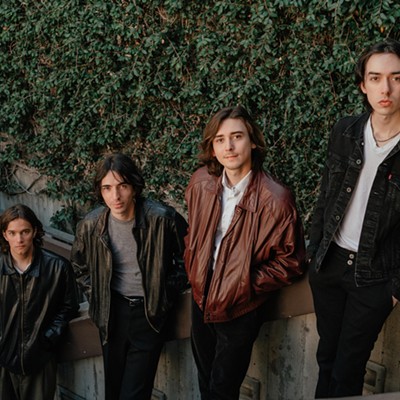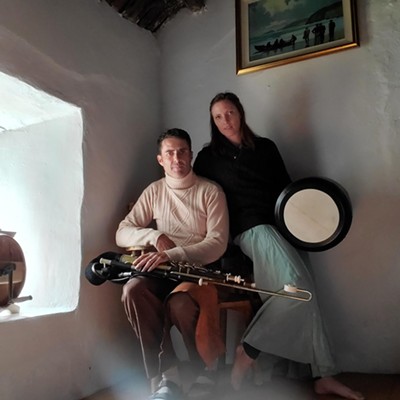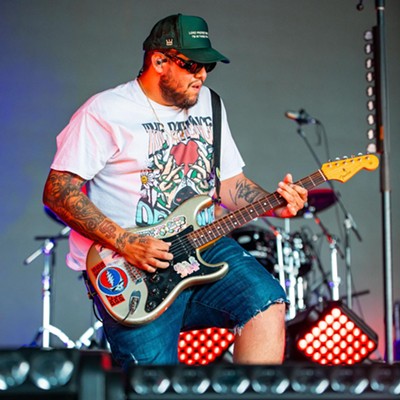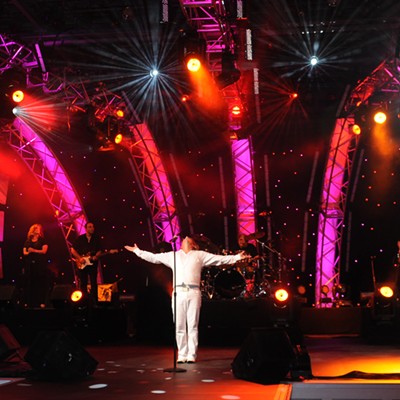In the late 1970s, as an art-school student in Philadelphia, Eye devoted his spare time to the town's skateboard community, one largely comprised of kids much younger than himself. "A lot of the kids looked up to me because I was older. I was living on my own, and I think they were kind of impressed by the fact that someone could still be radical and wild, and not be living with their parents," Eye remembers. Skateboard culture was at its peak; there were roughly one hundred skate-parks in the United States during that time, prior to their inevitable closure once the words "liability insurance" entered the lexicon.
The impact of those years remained with Eye in two very distinct and important ways. In the early 1980s, as the skate-parks shut their doors, and Eye was graduating from art school, the disenfranchised skate kids turned their energy toward something different: punk rock bands began springing up just as the skate-parks had years earlier, the energy and aggression of the sport manifesting itself into this new form of music.
As ollies and hand-plants gave way to chord changes and mosh pits, Eye became aware of his desire to mentor the kids he'd been hanging out with. He went back to school for a degree in education, with the intention of teaching art to elementary school kids upon graduation. But while attending classes, he never lost sight of his skate punk roots.
Student teaching by day, Eye hit the clubs at night, documenting on video nearly every band in the burgeoning punk scene that made its way through town. "I did nearly 80 bands; all of the famous ones like Black Flag, Circle Jerks, Dead Kennedys, Bad Brains, D.O.A., the list goes on and on," he recounts. "I stopped in '83 because things seemed to be getting sort of predictable, and the whole point in the beginning was that it was unpredictable." But the connections he had made in the music world would come in handy later.
In 1985, with the security of a brother living in town, and an eye toward discovering the West coast skate scene, Eye packed his bags and headed for Tucson. Used to a city life experience he simply couldn't find here, after two years of teaching art in elementary school he contemplated relocating again, but instead decided to make one last-ditch attempt at bringing some culture to town. In 1987, he found a state-owned building for rent at 31 E. Toole, a building he envisioned as a combination home/art studio/performance space.
Naming the building Dodajk Internation and utilizing the music business connections he made in Philadelphia, Eye began to host shows by touring bands such as Fugazi, NOFX, Helios Creed and Crash Worship. But the types of shows he wanted to bring soon outgrew the space limitations of the building. While he kept Dodajk -- later renamed Datura Studios and Gallery -- as his home and art studio/gallery, he began looking for a new home for his vision. He found it in 1991 in the form of another state-owned building located at 530 N. Stone Ave., currently the home of the Mat Bevel Institute.
The Downtown Performance Center hosted about 800 performances in its four-and-a-half year existence. Every show welcomed people of all ages; every show was alcohol-free, and nearly every show had an admission under five dollars. And while Eye was catering to an underground audience for most of these shows, he cites the fact that many of the artists that played there went on to become platinum-selling acts. "Bands like Green Day would be sleeping in my basement one day," he remembers, "and then the next day they're signing multi-million dollar contracts. Everything just transformed; that's the way it goes." In addition to Green Day, the DPC hosted The Offspring, Cake, Yo La Tengo, Jon Spencer Blues Explosion, Rancid, Stereolab, and G Love and Special Sauce, just to name a few. "It's weird, because at the time a lot of these bands were unknown, so not many people would show up. But those were some of the best shows, when it was still all fresh and new and exciting." He goes on to cite Cake, a band which performed at the DPC to a few dozen people, as a prime example; a few weeks ago Cake sold out the roughly 1200-capacity Rialto Theatre. "The DPC show was so great, and then this last time around they just looked like a bunch of bored rock stars to me. They just didn't have the same energy as they did back then. That's the beauty of seeing a band in a smaller space, before they've been co-opted by the corporate world."
But in 1995, things at the DPC began to sour. "I could speak volumes on what happened there at the end," Eye states. "I saw it as our last bastion of freedom, but a lot of people in this community just weren't supportive of what we were trying to do. There were a number of factors." Among them, Eye cites the financial difficulties resulting from income lost with the absence of alcohol sales and the presence of gutter-punks who completely disregarded the notion of what the space was trying to accomplish.
Eye is especially critical of the faction drawn in specifically by the harder punk shows: "They were people who traveled around the country, and they had no respect for the neighborhood. I had a really hard time dealing with those people. They destroyed private property in the neighborhood, and eventually it just took too much of a toll on the residents. No one wants to deal with that." It took its toll on Eye, too.
Exhausted from fighting the good fight, he finally gave in to the pressure and closed the doors of the Downtown Performance Center in the fall of 1995. He remained intently focused on his art and continued to teach art to grade-schoolers (until 1996), but felt emotionally and spiritually bereft. "I cared so much about what I was doing in the community, and I had put my heart out there so much that I kind of forgot who I was," he recalls. "Through trying to survive within the system, my whole spirit and energy and direction started to fall apart. By the end of the DPC I was so disoriented and ungrounded. It's probably a good thing that it ended when it did because the fire in my heart at that point was very low-burning."
Eye says it has taken him a full four years to recover from the experience, and claims that he has experienced no less than a full-on "healing process with my mind, my heart, and my spirit. What I did was find and remember my connection to the Mother Earth on such a deep level that it becomes such a passionate love affair that you're just constantly in awe of wherever you are and whatever experience you're having. I learned many things in my healing about holding judgement and not being a victim, and actually taking that love and putting it into action. And now, four years later I feel really strong." Strong enough, as it turns out, to start booking shows again. But this time his motivation has a decidedly different slant.
"What's calling me into action now is that the Mother Earth is speaking to me, telling me that what's needed now is good examples of creative energy to help inspire people in a positive direction of creating and being connected to the Earth. Because we've lost that connection. The way to find it is by helping people feel, and I've found that a musical performance or something else of that nature can bring such incredible inspiration and joy to people's lives."
To that end, Eye has started an events promotion company he calls Solar Culture, "named after an Atlantian cultural practice of opening and becoming aware of the pineal gland," essentially a part of the brain which functions as a third eye, thus allowing people to reclaim their power by being able to see through the constructs of society to the universe on a deep and primal level. And whether or not you buy into the New-Agey philosophy behind the project, Tucson music fans have already begun to feel the effects of the organization with the fabulous Pavement/Dirty Three/Giant Sand show held October 5 at the Rialto Theatre. Eye promises plenty more to come, including an upcoming performance from Stereolab and Olivia Tremor Control on November 18, also at the Rialto. He feels liberated by the ability to host events at a variety of different locations, and plans to find the most suitable location for each performance he books.
He's also sticking with the tenets on which he founded the DPC: keeping the shows all-ages and selling tickets as cheaply as possible. "It's a love thing. I just want to bring culture through town. My ultimate goal is to keep bringing larger and larger bands to town, bands I had only previously dreamed of (bringing)." He explains, "Someone once told me that it's a lot easier to live out your dreams than it is to outlive your dreams. So that's what I'm working on."
While Bjork and PJ Harvey top Steven Eye's dream list, he's interested in community input. E-mail him at steveneye@hotmail.com and let him know which bands you'd like to see come through town.







